Clash Royale Esports Scene (2025Q3)
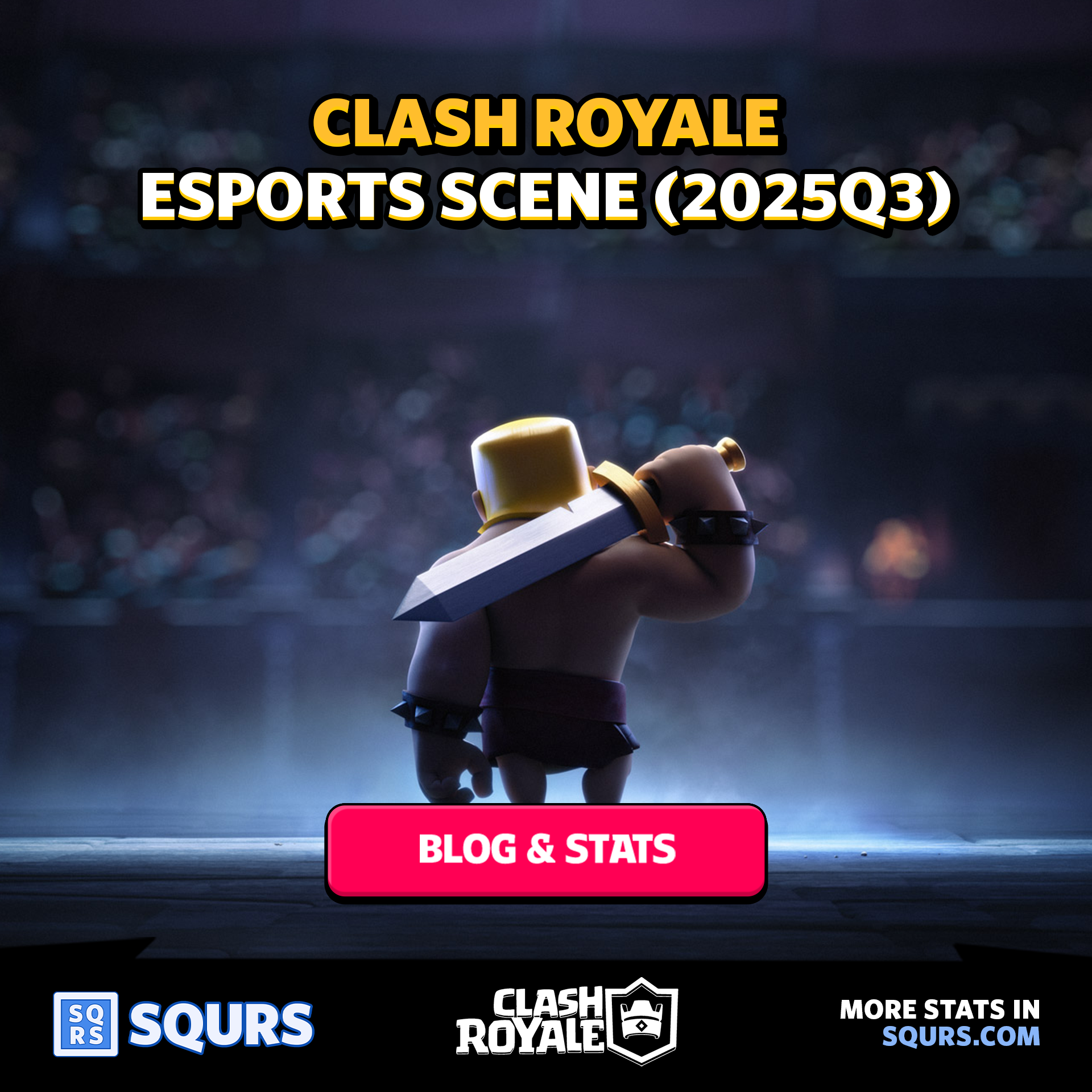
Authors:
Last updated: 2025-07-25
Page change log:
- Created: 2025-07-25
Page contents
How much money has been dumped into esports? Are esports still relevant for Clash Royale? What could be their future?
In this blog we'll be looking at general stats from the last decade to find the answers!
The role of esports
Showcasing gameplay depth
Clash Royale is a strategy game, and having a perception of depth and skill has been important for its organic growth. It diverts attention from the time and money needed to level up the card collection, showing there are other ways to outperform opponents.
This depth isn't obvious for starting players, but when level upgrades slow down, deck building and card placements become more relevant. Discovering these layers makes the game depth visible, which is important to create long term goals and improve retention.

The impact of gameplay depth is conveyed at very different levels: arenas, challenges, leaderboards, social media content... esports are the last stage of this ladder. They provide a platform for the best players to compete, which allows gameplay depth to reach its limit.

A way out for players
From the player's perspective, it's important to recognise that esports events provide a potential way out. Similar to content creation, it is presented as a potential way to sustain their real lives through prize pools and other partnerships.
Based on our data, the opportunity to become a professional player looks more like an illusion rather than a realistic path for most players; but goals don't have to be rational to guide player behaviour.
A marketing strategy
Many games consider esports events as part of their marketing efforts and budget. At least for Clash Royale, there's not much data supporting this framing. Esports content and assets are almost never used in ad platforms, and the audience of these events is very limited compared to regular content about the game.
Official comments
Supercell has almost never been very explicit about their real goals with esports. Some related comments are:
We want to create games that people play for decades, and games that will be remembered forever, and for a competitive game like Clash Royale, it feels obvious that e-sports must play a role in that.
It started with us noticing that, in everything we had done previously, the top players were part of team organizations. We didn't initially expect that because of how you play our game, but we noticed that players got a lot of value from teams. We started talking to teams more and more and realized there's an opportunity to formalize that in a way that can be good for our players, both competitors and viewers. That inspired the Clash Royale League, which brings in a few innovations, with team experience and resources to give players more stability and structure.
We're all working towards the same thing: to make content that's competitive and fair but also really interesting to watch, the whole league is very much a collaborative effort between us and the team organizations; from Combine scouting, to rules and even the content itself.
Supercell does esports because we think it makes the game better. It makes players engage with the game more deeply and, hopefully, play longer.
Taken at face value, these comments imply that esports were initially valued for how they could enhance the whole Clash Royale ecosystem. A tool to keep the community engaged and increase the lifespan of the game.
History Recap
The CR esports scene has gone through different stages. To make sense of the charts in the following sections, this summary may be useful.
2016: Game launch
- January: iOS soft-launch happened
- February: Android soft-launch
- March: iOS and Android global-launch
2016: First live tournament in Helsinki (Finland)
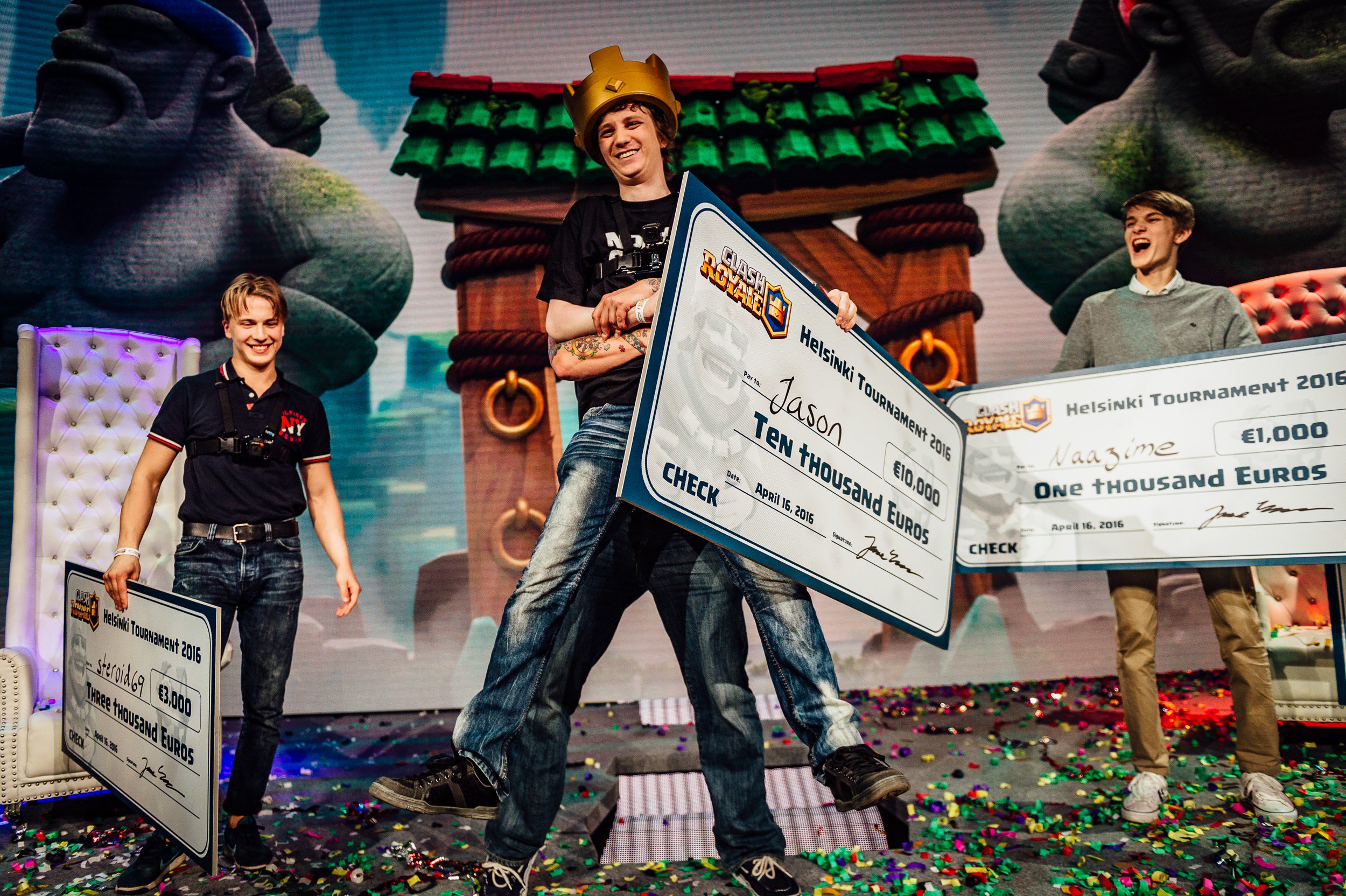
The first official event was held in April 2026, with a prize pool of $15,000 USD. This event mostly featured a mix of local participants and invited content creators.
2016: Grassroots events
The first competitions in CR history had very minor prize pools and relevance. There was no sense of esports scene. Some relevant mentions are:
- April: Super Magical Cup
- June: Royale Premier League (RPL)
- July: Clan Royale League
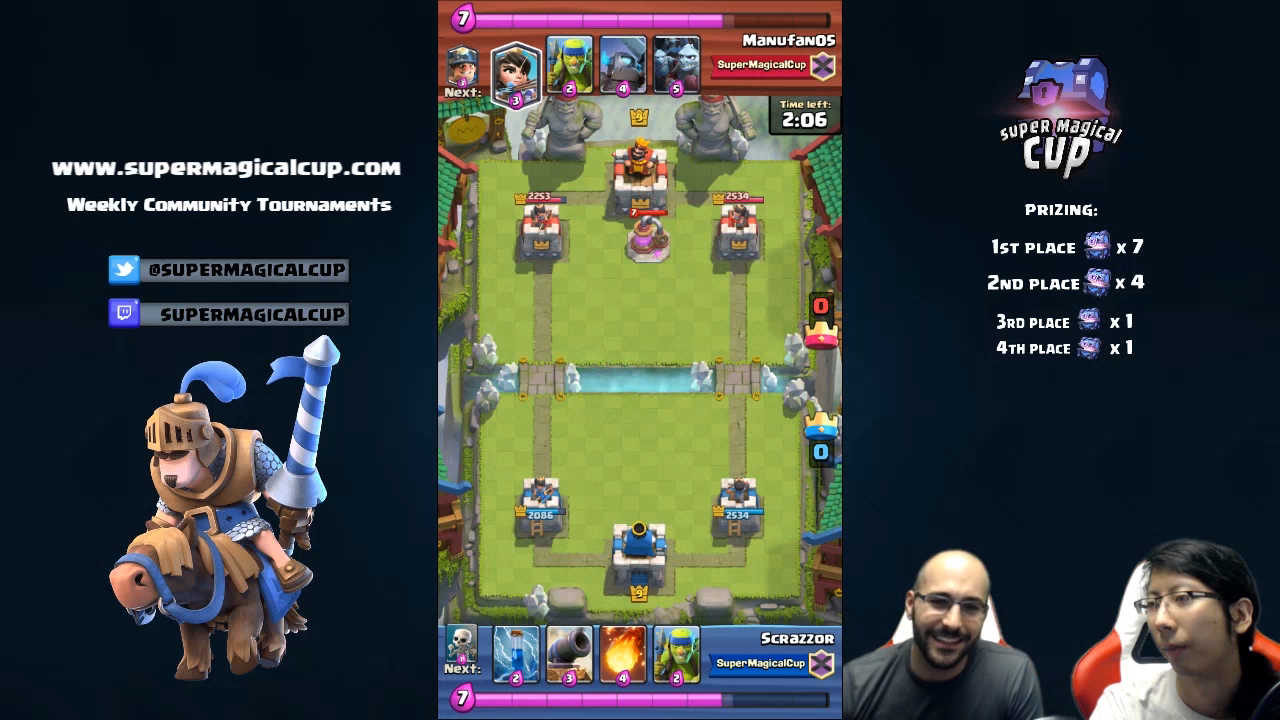
Super Magical Cup was probably the first unofficial event with a serious organisation and format. Despite having a modest setup an prize pool, they attracted talented players from around the world and quickly became well known.
One of the two main casters, known as The Rum Ham, would later join Supercell and become a Community Manager for Clash Royale.
2016: Medium esports events
Clash Royale started to show up in the roster of competitive games for some live events. Some relevant ones were ESL SG Callao Arena (Spain), Brasil Game Cup (Brazil), DiGi CrownWars (Malaysia), ESWC (France), ESL Premiership (India)...
2016: More official events
After the popularity of the live event in Helsinki, Supercell creates other competitions with high quality production, such as Clash Royale NA Open (United States) and Kings Cup (United States).
2017: CCGS
The Crown Championship Global Series (CCGS) formalised the esports scene for Clash Royale, with a long format in which players competed for several months.
Towards the end of the year, the best players would reach the World Finals, with a prize pool of $400,000 USD.
2018-2020: CRL for teams
Until this point, Clash Royale events had been mainly for individual players. The Clash Royale League was introduced a new format that would feature dozens of well established esports organisations from other games of the industry.
This was an image I made in 2019, with very questionable graphic design skills. But it shows a lot very relevant teams as participants, and this was while the esports scene in general was at its prime.
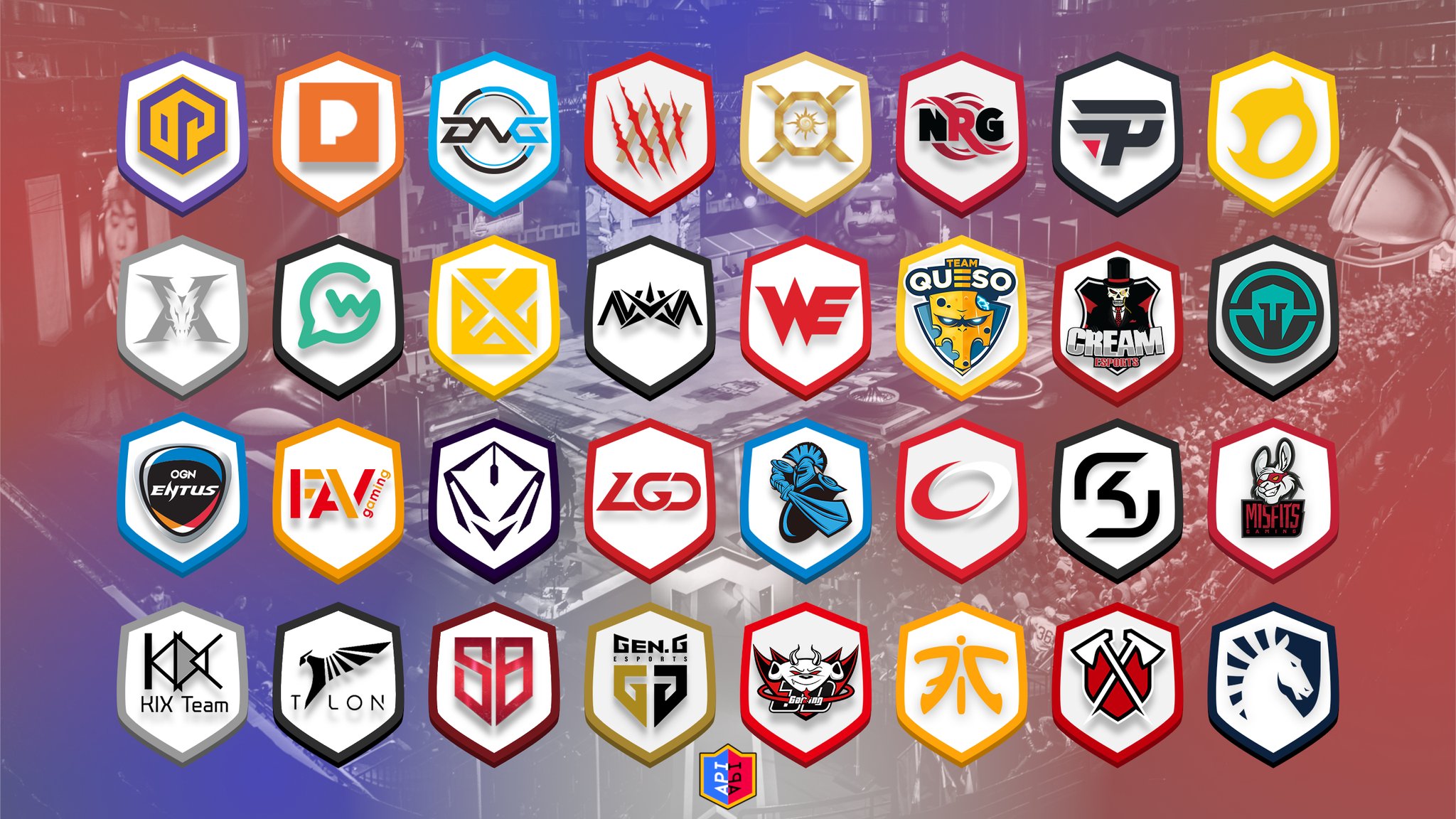
CRL for teams was distributed in several regions, and had very significant costs. Aside from the prize pool and the production costs of events with durations of multiple months, sources say that teams would also receive subsidies from Supercell to cover (some of?) the wages and expenses from players. This is possibly one of the main reasons that convinced top tier organisations to join this competition, despite the stigma they had against mobile gaming.
2019: LPE. A missed opportunity?
Barcelona (Spain), Ajax (Netherlands), Galatasaray (Turkey), Santos (Brazil), Real Sociedad (Spain) and Villarreal (Spain) are among the many professional sports teams from around the world participating in the LPE. Tokyo Verdy from Japan is also scheduled to participate.
Founding of the League of Professional Esports (LPE) press release
Our sources also included teams such as AS Monaco, Guadalajara (Mexico) aka Chivas, Getafe (Spain), Orlando Pirates (South Africa), PSG (France), Real Sociedad (Spain), Villarreal (Spain), Eibar (Spain)... This event was expected to bring together very well known football teams into the esports scene.
This competition was almost ready to start, but sources say it was cancelled due to not being approved by Supercell. The same sources also speculated that the main reason was the direct conflict with CRL.
2021-2025: Individual CRL
Towards the end of 2020, Supercell announced a new format for CRL that wouldn't be based on teams.
2021 will bring forward many changes to CRL, starting with the Supercell team working on the league. The main takeaway is that this new team will include members of the Clash Royale development team - this is a huge win for CRL in the long run!
Our goal is to create an esports experience that closely mirrors the way all Clash Royale players are experiencing the game, and create a direct path for them to play competitively.
These goals of integration with the Supercell team were never materialised in a meaningful way. League ops and production would soon be delegated to a 3rd party, Esports Engine (later Vindex, later ESL FACEIT). This organisation managed a basic implementation of Althlos in-game, but participants would regularly experience delays and other issues.
In 2025, this partnership seems to be over. CRL is now delegated to smaller organisers like QLASH and Calalas Cup, who provide a face and league ops for the event, but follow a uniform format.
Esports Database
RoyaleAPI has the most complete esports database for Clash Royale. This database is focused on tracking player results and prize distributions, and has been collecting data consistently since 2016.
Although it tracks all the most relevant events, it does have some limitations. The main ones are:
- Only events with a prize pool above $500 USD are eligible
- Tournaments must follow Supercell's Tournament Guidelines
For the purpose of seeing general trends of the scene, none of these should be a relevant impediment.
At the time of writing, the database contains:
- 600+ individual events
- 200+ team achievements
And in terms of aggregate prizes:
- $8,958,000 USD with individual events
- $4,510,000 USD with team achievements
Key Insights
Clash Royale esports events have rewarded players more than $13M USD in prizes over the last 10 years.
It's relevant to note that this amount simply takes into account prize pools and not esports spending overall. All the overhead costs of production, league ops, promotion... aren't included here.
Individual VS Team Events
Although Clash Royale is mainly an individual game, it does have some social features such as 2v2 and clans that promote a social component. Players play and train together, so team formats are a decent fit with some advantages and disadvantages.
Event Counts
If we simply look at event count, it's easy to see that Clash Royale has always leaned towards individual events. This format is closer the ordinary player experience, and is usually easier for event organisers to handle.
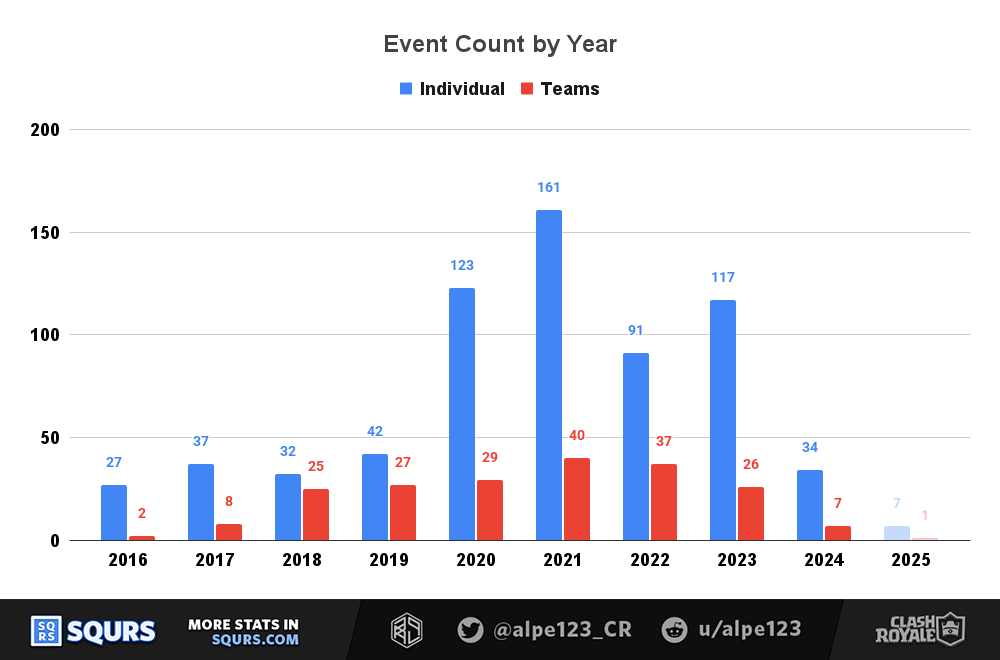
In every single one of the years we have tracked, there have been more individual events than team events. This is easier to see in a stacked share chart:
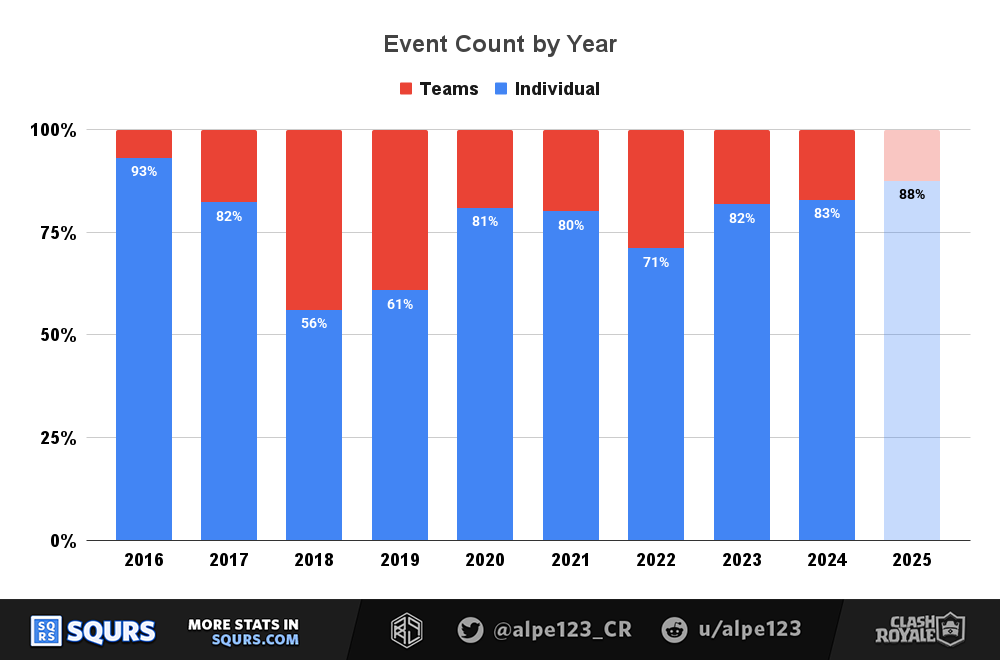
Key Insights
Team events peaked by popularity at around 2018-2019, and became less relevant afterwards.
It's worth noticing the trend towards individual events that returned before the CRL teams format was cancelled; possibly due to the COVID-19 pandemic.
Aggregate Prize Pools
Another way to look at events is through their aggregate prize pools. This framing gives more relevance to the big events, which are usually sponsored directly by Supercell.
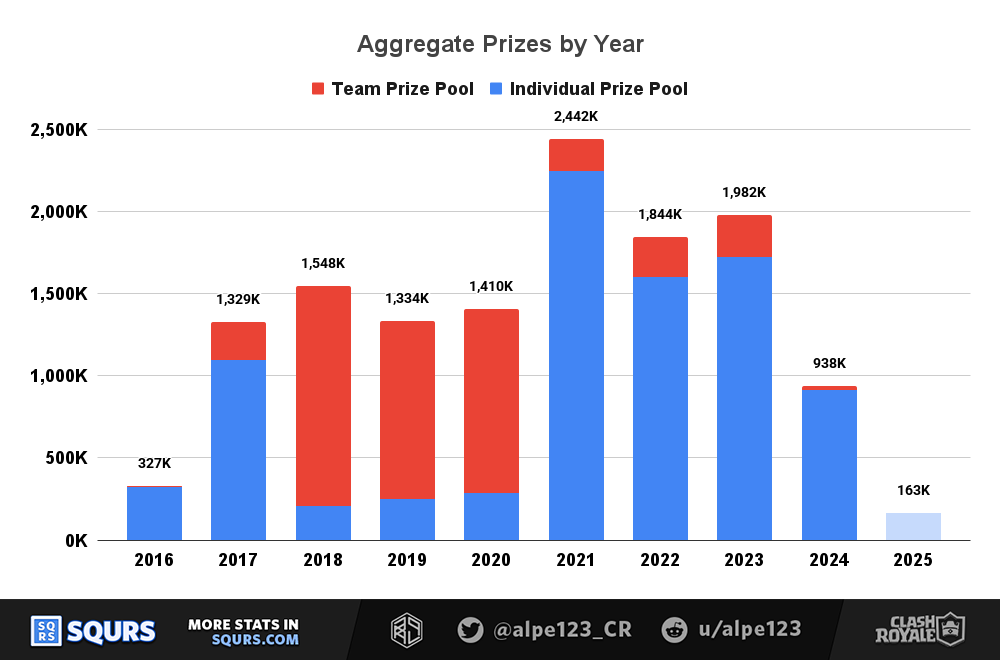
Values for 2025 don't include scheduled events, only completed ones; it is expected for the final prize pool to sit between 700K and 800K USD, ~20% less than the previous year.
In the History Recap section we already saw that there was a 3-year period (2018-2020) in which Supercell heavily pushed for team based events with CRL. This push was naturally followed by other events and tournament organisers, and is very visible with these aggregate stats.
A stacked share chart is the best way to see this effect in prizes:
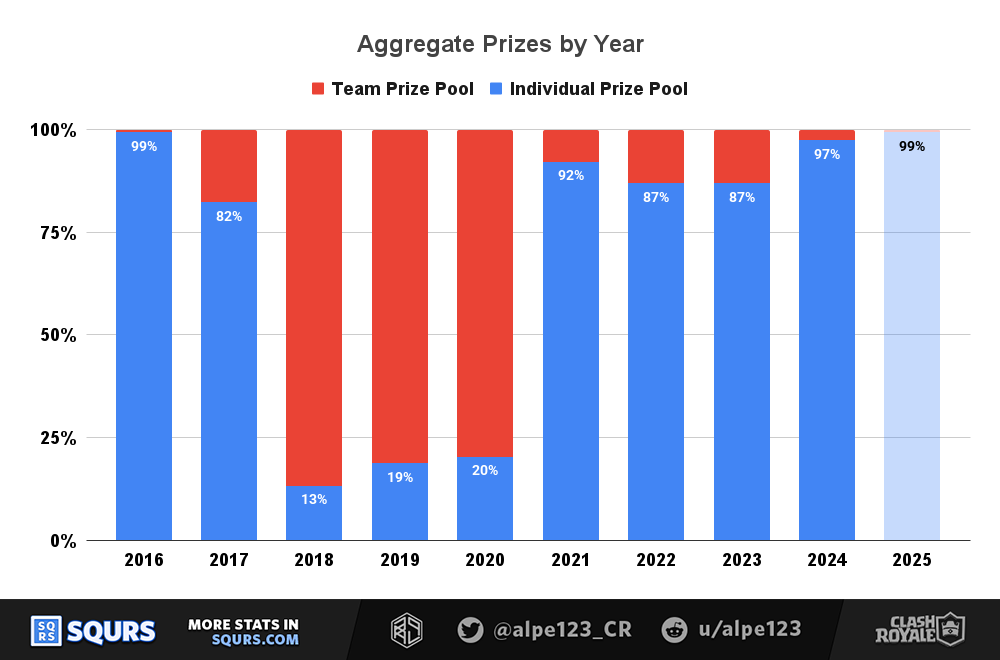
During CRL for teams, the split of individual-teams of 80-20 was completely inverted to 20-80.
Supercell Funding
It's not easy to know how much of this prize distribution ha been directly funded by Supercell. The case for CRL is obvious, but they have also provided prizes for many grassroots events over the years.
But not all events are equally transparent with their funding, so the best we can find out is the minimum amount that was funded by Supercell. The most reliable way to do that is by looking at official events and those that are part of the CRL circuit.
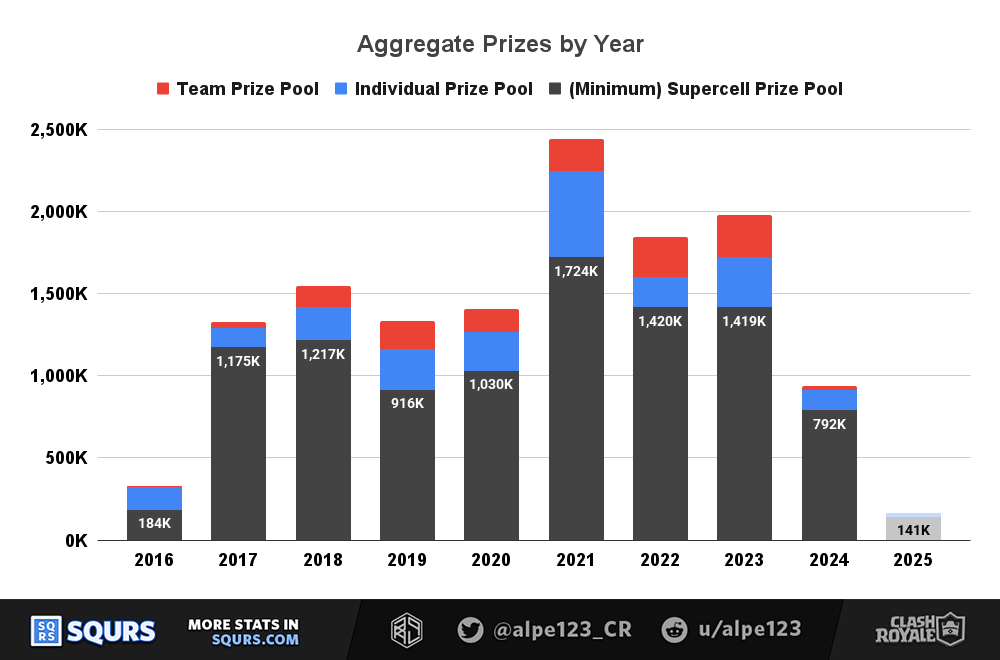
During 2024 and 2025, their investment was approximately cut in half when compared to previous years.
Looking at the share of prizes funded by Supercell gives a very clear read: the esports scene of the game is mainly sustained by the game publisher.
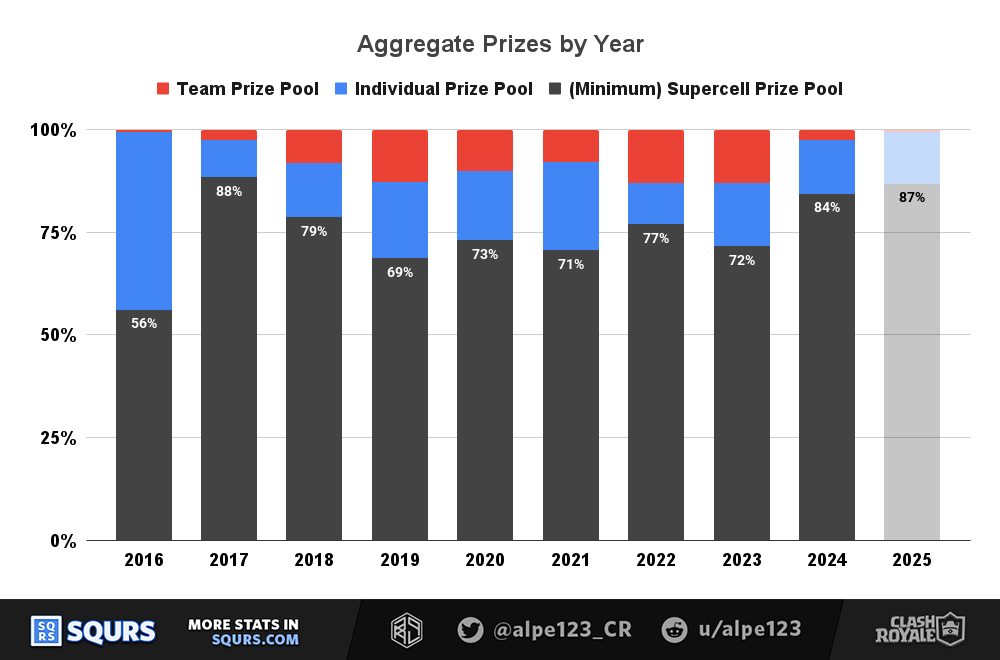
Key Insights
At least 70% of the Clash Royale esports scene prizes are from official events, funded directly by Supercell.
During the last 2 years, this share has increased to almost the entirety of the scene. There are barely any sponsorship efforts that would make this environment more sustainable.
Supercell's Tournament Guidelines are very strict in this regard, creating a very high barrier for interested 3rd parties. Some of the most notable rules are:
All tournaments must be free to enter for the players—no exceptions! This includes things like membership fees or season passes.
Your event cannot involve gambling, paid raffles, or fantasy sports betting.
Your tournament or event can't promote other game companies, game publishers or game platforms, alcohol, tobacco, drugs, pornography, weapons, cryptocurrency, blockchain technology, betting or gambling, or any companies, products or services related to the above.
Player Earnings
Based on the prize pools of the esports database, RoyaleAPI also provides an Earnings Leaderboard. How balanced is the distribution of earnings among top players?
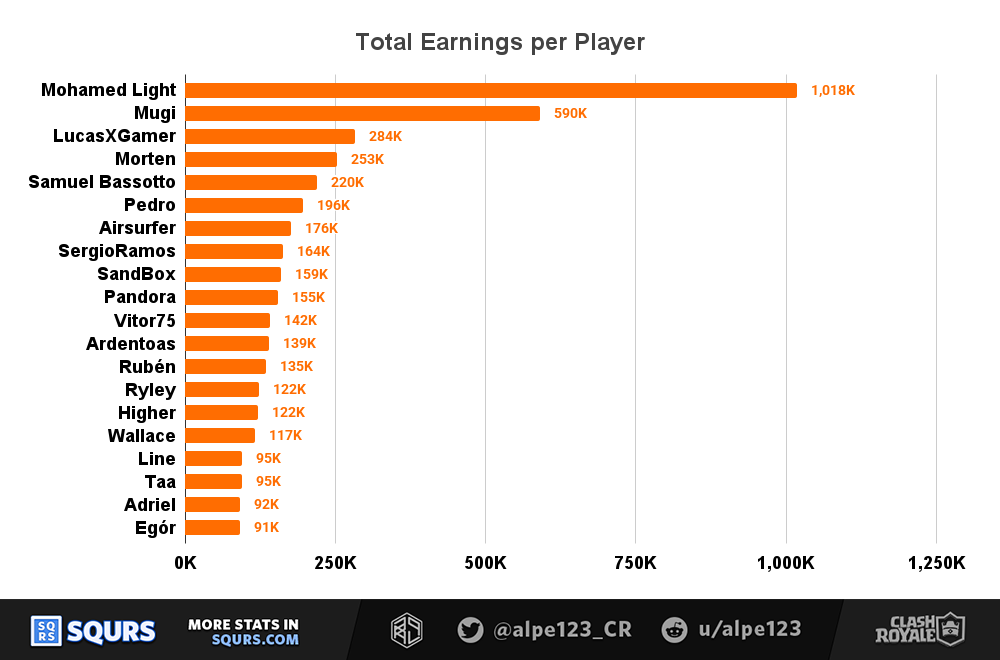
As we mentioned earlier, the prizes of individual events add up to $8.96M USD. This means that:
- Top 1 player: $1.0M, 11% of the total.
- Top 10 players: $3.2M, 36% of the total.
- Top 50 players: $6.0M, 67% of the total.
- Top 100 players: $7.1M, 79% of the total.
Key Insights
Mohamed Light is the Clash Royale player with the most earnings accumulated from individual events. With more than $1M USD earned, he has collected ~10% of the available prize pools by himself.
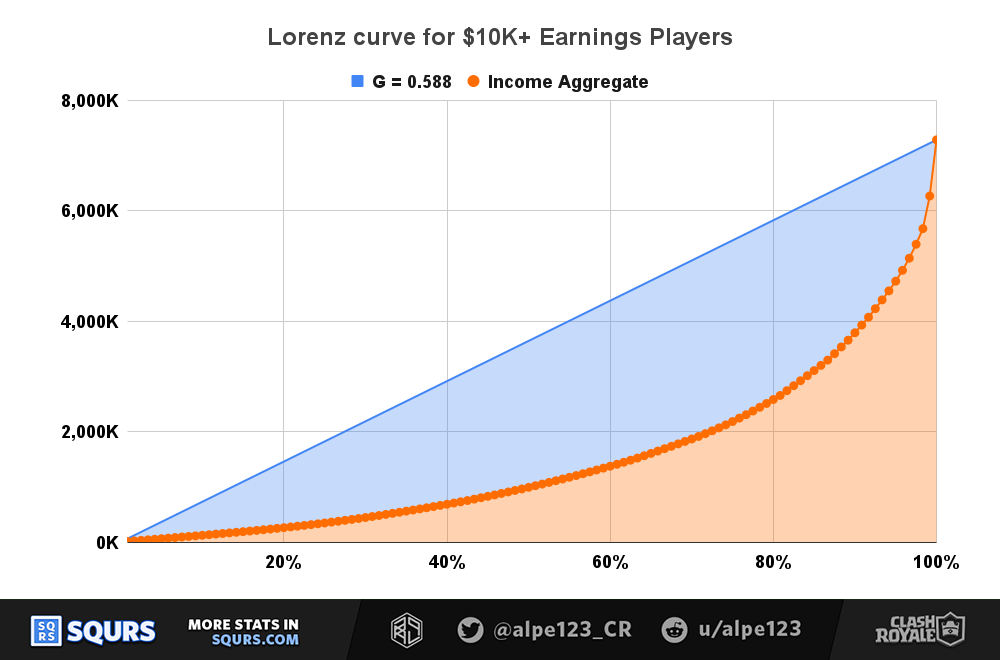
The RoyaleAPI esports database has around 1,400 players with esports earnings, and more than 26,000 enlisted players in total; only 120 have reached $10K USD in earnings. A very small amount of players has collected almost all of the available prize pools, which isn't too surprising for a strategy game in which the better player is able to win very consistently.
Separating the total earnings by year shows that most of the top 20 players earned their main prizes between 2021 and 2023. This makes sense when paired with the distribution of individual events we saw earlier, this 3-year period stands out from the rest of the decade.
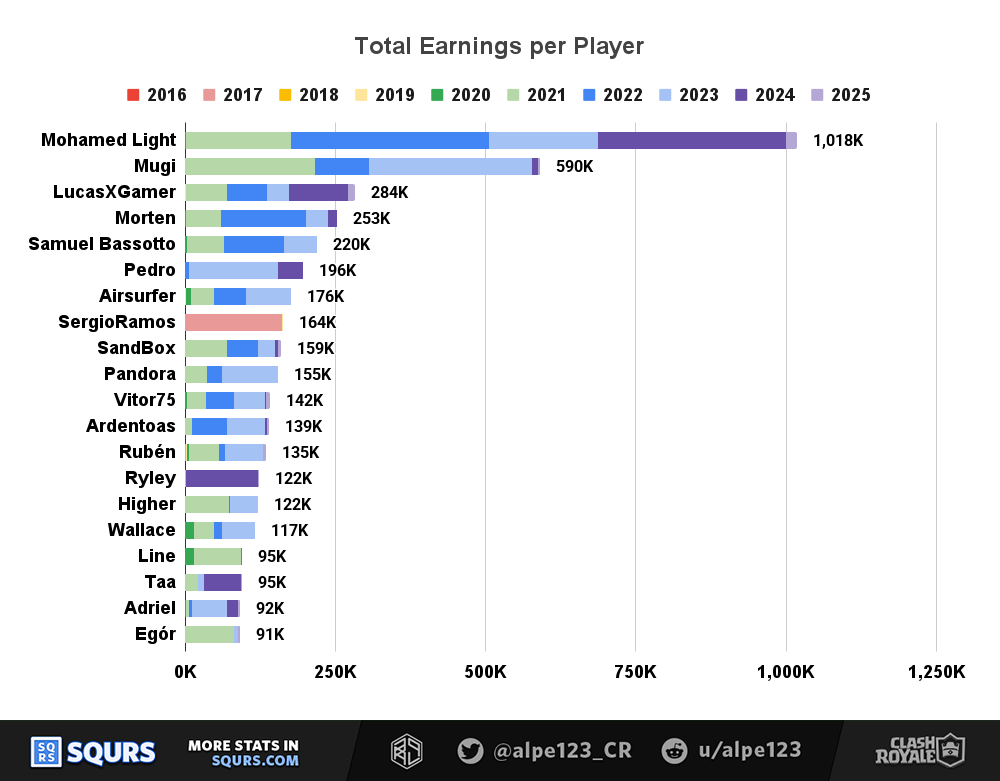
The future of CR esports
The declining trend in investment for the competitive scene should look concerning for those who care about it.
One of the main takeaways from these stats is that the scene is completely dependent on Supercell's will to fund these events. Based on this, the three main options seem to be:
Reduce the dependence on Supercell by finding 3rd party sponsors and investments, or by making it more sustainable. This seems challenging based on the current guidelines.
Provide clear value to Supercell in return for their funding. Can esports make players more engaged and willing to spend?
Hope that Supercell keeps investing in esports despite the questionable benefit.
It's worth noting that nowadays it is Supercell who mainly controls the format and structure of the scene, so there doesn't seem to be much room for anyone else to push competitive Clash Royale in a different direction. Maybe heavy-weight influencers like Jynxzi can prove there's interest for new approaches, but CRL hasn't had meaningful innovations in recent years.
A more positive framing is related to the health of the game. If we suppose that esports funding is a function of game revenue or profits, the budget for 2026 may increase significantly due to the great performance that Clash Royale is currently experiencing.
It's hard to say which of these two scenarios is more likely, so we'll have to wait until the 2026 season to find out. This will show us what the main goal of CR esports truly is, and whether it's doomed or a lifetime companion for the game.
Do you have any questions or requests for future content? Join our Discord Server and let us know!

 Alpe
Alpe